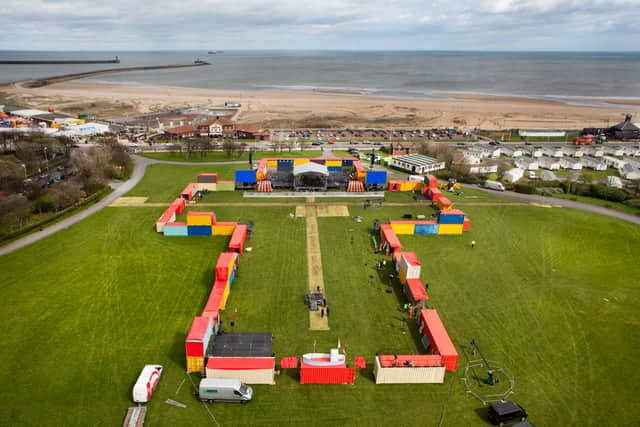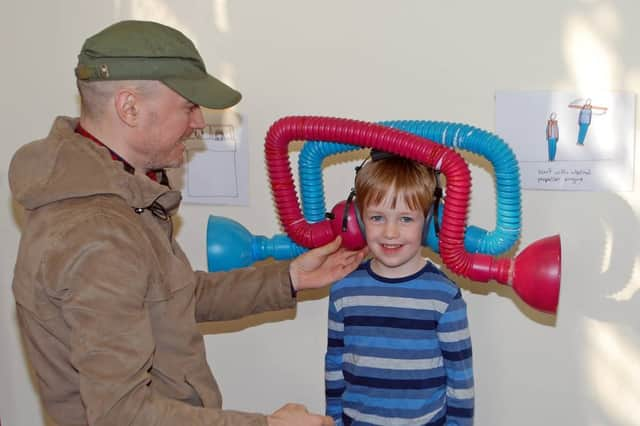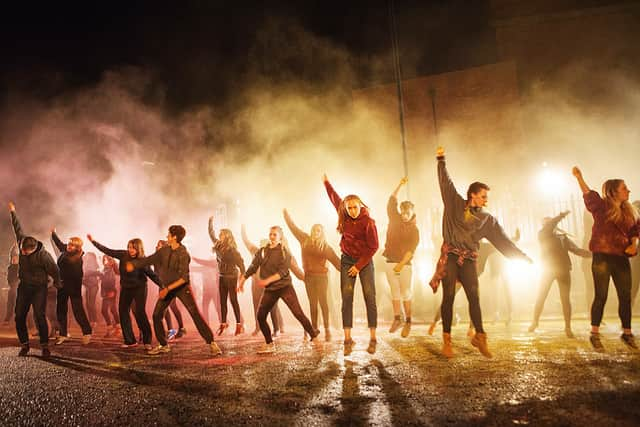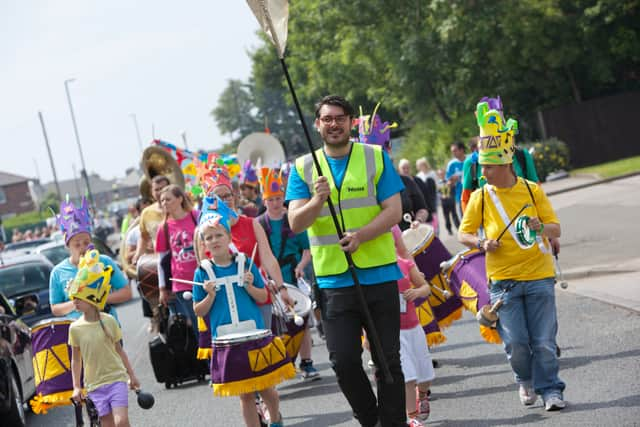The Cultural Spring celebrates 10 years of boosting arts participation in Sunderland
and live on Freeview channel 276
Ten years ago this month The Cultural Spring started its work to increase participation in arts and culture within Sunderland and South Tyneside.
The project began with £2million of funding from ACE’s Creative People and Places programme and was extended in 2017 and then again in 2020 and 2023, when the focus of the project was turned solely on to Sunderland. A Cultural Spring Charity was established in 2020 to continue the good work in both boroughs.
Advertisement
Hide AdAdvertisement
Hide AdRob Lawson looks back at a decade of success, stories and the legacy of the award-winning project which has engaged more than 90,000 people in the area in the arts - enough to almost fill the Stadium of Light twice!
How it all began


Although very much focused on a local agenda, The Cultural Spring was launched on a national stage – BBC1 no less!
The project’s first event was The Great North Passion, a spectacular live retelling of the Passion story broadcast on Good Friday, April 18, 2014.
In the months leading up to the live broadcast The Cultural Spring had worked with local communities and artists to produce content for 12 huge shipping containers that reflected the spirit of the community as well as representing one of the Stations of the Cross.
Advertisement
Hide AdAdvertisement
Hide AdThe containers were then joined together in Bents Park, South Shields, to form a huge cross-shaped installation.
Since then The Cultural Spring has produced several major eye-catching and critically-acclaimed performances and events in both South Tyneside and Sunderland.
Grassroots culture
But the majority of its important work in bringing art and culture into local communities has been on a much smaller, but equally effective, scale.
Seasonal programmes of workshops held in community centres, church halls, and other ultra-local venues gave people the opportunity to try something new, learn a new skill or develop an existing talent.
Advertisement
Hide AdAdvertisement
Hide AdProgrammes included creative writing, calligraphy, ceramics, ukulele and guitar playing, African drumming, proggy mat making, water colour painting, animation and zine workshops, and many, many more.
Through its Your Art scheme, the project invested more than £100,000 to support grass-roots community organisations while at the same time providing the organisations with practical support and advice.
And throughout its first decade, The Cultural Spring has provided thousands of people with the opportunity to explore art outside of their home areas through Go and See trips to theatres, museums, festivals and exhibitions.
A top priority for the project has always been to leave a lasting legacy on Wearside and South Tyneside. To ensure that when The Cultural Spring is no longer, an infrastructure exists so arts and culture remain an important part of the communities it has served.
Advertisement
Hide AdAdvertisement
Hide AdThe increasing list of self-sustaining groups originally launched through The Cultural Spring include Hylton Ukes who started in Hylton Castle, and Creative Crafts and Whitburn Acapella in South Tyneside. More than 20 organisations across the two boroughs which were set up through The Cultural Spring are now self sustaining, that is running without the financial support of the project.
Benefits to the community


While its role has always been to increase the number of people participating in arts and culture across Sunderland and South Tyneside, in doing so the project has provided meaningful employment and commissions to hundreds of local artists and arts practitioners – and supplied dozens of community venues with a valuable source of income through bookings for Cultural Spring workshops, activities and events.
This was of particular importance in the wake of Covid lockdowns – a period when The Cultural Spring continued to work in arts engagement by sending out thousands of craft packs to particularly isolated people.
Paul Callaghan CBE, Chairman of the Music Arts and Culture Trust (MAC Trust) and a driving force behind the project, remembers the beginnings of The Cultural Spring:
Advertisement
Hide AdAdvertisement
Hide Ad“In 2012 and 2013 we were just launching the MAC Trust and we were looking for our first big project which we hoped would lead to real positive change to people’s lives.
“Grayson Perry, the celebrated artist, writer, and broadcaster had just made three documentaries called 'All in the Best Possible Taste', choosing Sunderland to exemplify working-class culture. I remember watching the Channel 4 broadcast, dreading and half-expecting another metropolitan-centric, patronising depiction of Northern Chavs, 'Cultural Benefits Street'.
“Instead, it was a warm, sensitive reflection of our people, he not only liked us, ‘he got us’. So, we used his updated version of the 'Rake's Progress' as the theme for our bid to Arts Council's Creative People and Places programme - and ‘they got us’.
“We were awarded sizable funding from Creative People and Places and we launched The Cultural Spring.”
Advertisement
Hide AdAdvertisement
Hide AdThe MAC Trust sat alongside University of Sunderland, and The Customs House in South Shields as founding partners in the project.
Ray Spencer, Executive Director at The Customs, explained why his organisation has supported the project since the beginning and the difference it has made in South Tyneside: “The Customs House has always believed that cultural creativity should be accessible to everyone, as participants, performers and producers. It was clear that in our community, there was a degree of uncertainty, a fear of crossing cultural thresholds.
“Engagement in the arts was ‘for others,’ participation something young people may do at school but it was ‘not for adults.’ Art was offered to the community, it was never produced, created and curated by the community.
“The Cultural Spring and the Creative People and Places programme gave opportunity to communities to take control and ignite new and revisit old passions in the arts in their broadest sense.
Advertisement
Hide AdAdvertisement
Hide Ad"Menus of opportunities were presented to the communities in which they could engage in familiar places, from social clubs, church halls, schools and pubs.
“From family activities to major national events, our communities discovered art and creativity was for them, it enriched their lives and that of their communities and in doing so promoted civic pride and reduced isolation whilst promoting social cohesion.
“No longer did residents need to travel to major cultural providers to engage in creativity they may well have national events happening in their community. Many saw for the first time, how engagement in and appreciation of the arts added value to their lives and how they added value to the creation of great art.
“Traditional venues and cultural providers had to revisit their offer, to question their engagement and enter into conversations with the communities they served.
Advertisement
Hide AdAdvertisement
Hide Ad“The Cultural Spring’s Community Champions became commissioning consumers, empowered to question artists and help shape the projects and outcomes, making choices not having predetermined work imposed on them. Like most revolutions it rose from the streets and in doing so turned a cultural spring into this gloriously creative summer.”
A proud milestone


Graeme Thompson, former Pro Vice Chancellor External Relations at University of Sunderland, and Chair of The Cultural Spring’s steering group, said: “I’m so proud of what we have achieved in our first ten years – we definitely opened the floodgates for investment in arts and culture across Sunderland and South Tyneside.
“Funders and local authorities recognised that supporting communities to engage with music, arts and crafts had economic impacts as well as a positive effect on bhealth and well-being. It was a real wake-up call.
“The cultural strategies for Sunderland and South Tyneside, Sunderland's City of Culture bid and the setting up of organisations such as Sunderland Culture all happened because of The Cultural Spring. As a result, our work in the area over the last decade is used by Arts Council England as an exemplar of the way in which community arts can be a springboard for culture-led place-shaping and regeneration.
Advertisement
Hide AdAdvertisement
Hide Ad“We've also benefited from brilliant leadership. Our founding director Rebecca Ball and our current director Emma Horsman have established national reputations in community arts. We've also been incredibly fortunate with our founding partners the University of Sunderland, the MAC Trust and the Customs House as well as funders and supporters including ACE, the local authorities the BBC and so many charities and community associations.”
Discovering a new passion


Sandra Naglis, a retired primary schoolteacher, now sits on the steering group Graeme chairs, but her relationship with The Cultural Spring started in its first year when she signed up to be part of RUSH!, an early commission for dance company Southpaw: “In 2014 I heard about some dance sessions on offer.
"As you didn’t need to have any dance experience, they seemed ideal for me. With a patient, understanding dance teacher, all of the participants were soon picking up the dance routines.
“Before long, we realised these were to be part of a dance performance at St Hilda’s Pit Head. The thought was extremely nerve wracking but it turned out to be an exhilarating experience, performing alongside dance professionals and I was hooked.
Advertisement
Hide AdAdvertisement
Hide Ad“I learned The Cultural Spring had lots more on offer. I began signing up for a wide variety of their workshops and tried out many arts and crafts. The reassuring phrase was ‘no experience necessary’ which helped me take the steps into the unknown.
"I found myself taking part in singing workshops which led to performing in an opera ‘Miracle’, in more thrilling dance productions, a drama group where I tried my hand at a bit of acting and a guitar group that helped me dust off my guitar and eventually pluck up courage to play in public with others in the group.
“I became a big fan of The Cultural Spring. As well as making lots of new friends along the way, I was constantly encouraging friends and family members to give some of the workshops, activities and other offerings a try. As a consequence, I became a Community Champion for the organisation.
“The Cultural Spring always encourages members of the community to have their say. I soon became involved in decision making panels for Your Art and other projects and attended open meetings to listen to plans and give opinions on upcoming projects.
Advertisement
Hide AdAdvertisement
Hide Ad“I continued enjoying many activities that Cultural Spring had to offer, continued supporting them whenever I could and was delighted when I was asked to become a member of their steering committee.
“From the beginning, it has opened up a whole new world for me. The last ten years with The Cultural Spring have pushed me out of my comfort zone, made me realise how much enjoyment and satisfaction there is in taking part in the arts. I’m constantly on the lookout for new opportunities and now have no hesitation about signing up for anything different or challenging with lots of other organisations.”
Funding boost
Laura Brewis, founder of We Make Culture CIC, is an arts practitioner who was also an early engager with the project: “The Cultural Spring has played a massive part in all of We Make Culture's work - in fact, we would not exist without them! They gave us our first ever funding - a £400 Your Art commission - which enabled us to take a risk and start our first project, Pop Choir.
“From a reasonably small investment and a ton of support, The Cultural Spring enabled to learn as we go and we have since partnered with them on all sorts of things, from leading workshops to producing our first ever mini-musical, Sweet Caroline and the Football Boots, which was part of last year’s Bitesize programme.
Advertisement
Hide AdAdvertisement
Hide Ad“The Cultural Spring has been pivotal in changing how organisations approach working with communities in Sunderland and South Tyneside, meeting people where they are, being led by participants and moving arts and culture out of institutions and into the places where people live and work.
"It's an approach that We Make Culture have learned such a lot from and Sunderland is so much richer for having it here.”
Everyday Art


Emma Horsman, Project Director for The Cultural Spring, said: “Our vision has always been for arts and culture to be an expected and accepted part of everyone’s lives in Sunderland and South Tyneside.
“It's the people who we've met and continue to meet who say 'art isn't for the likes of me' that spurs us on because we believe that it is, or it can be, and you're exactly the person we want to engage in The Cultural Spring.'
Advertisement
Hide AdAdvertisement
Hide Ad“We’ve collectively - and I include residents, artists, partner organisations and the Cultural Spring team in this - done so much to improve the cultural landscape and ecology on both Wearside and South Tyneside.
"Local people have been open and generous about sharing what they want to see happening here and in so many communities and estates this has ignited a passion for the arts, introducing thousands of people to new activities, hobbies and skills.
“We’ve also benefited from working with a fantastic range of artists, giving hundreds of freelancers and organisations valuable work and experience, and developing genuine relationships with local residents in both places.
“What’s important is that this momentum is not lost. We still have the same energy and ambition we had ten years ago, and we know we haven’t finished our mission – that there is more to do.
Advertisement
Hide AdAdvertisement
Hide Ad“We know that we've created sustainable arts activities and groups and we will create more. More importantly than that we've connected people, friendships have been formed, we've even seen a few romances bloom!
"We know that if and when The Cultural Spring is no longer a feature in the two areas, we’ll have done enough to convince our communities that arts and culture are for everyone to enjoy – and that they’re not a ‘nice to have,’ but a ‘must have.’
“As a team we have thoroughly enjoyed the past ten years and the experiences and opportunities we've been able to co-create with everyone that's come into The Cultural Spring and here's to the next ten years!”
Comment Guidelines
National World encourages reader discussion on our stories. User feedback, insights and back-and-forth exchanges add a rich layer of context to reporting. Please review our Community Guidelines before commenting.